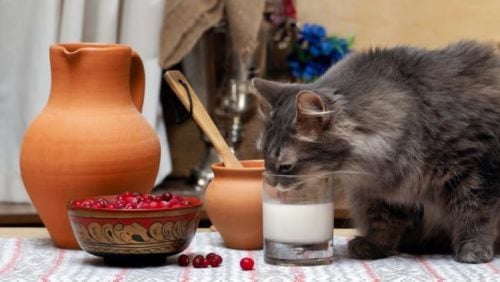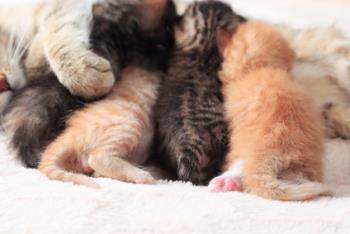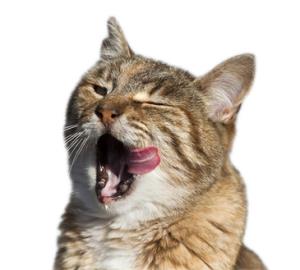Do you give milk to your cat? Many people do. After all, it’s a delicious treat for cats. Unfortunately, giving milk to your cat often leads to developing signs of lactose intolerance, such as diarrhea and vomiting.

In reality, do cats need milk? Is milk bad for cats and can you give milk to your cat? Let’s find out.
Can you give milk to your cat?
- If your cat develops signs of lactose intolerance after drinking even a small amount of milk, you should avoid giving milk to your cat.
- If your cat shows no signs of lactose intolerance, milk may be considered safe, if given as a treat.
A treat means no more than 5% to 10% of the total daily caloric intake, which, for an average cat, is no more than 2 to 3 tablespoons of 2% skim milk. Overweight and obese cats should not receive extra treats of any kind.
Is milk bad for cats?
Milk isn’t all bad, but, taking the opposite approach, we could ask: Why is milk good for cats? Why should it be? Cats naturally don’t drink milk. At least we haven’t seen a cat sneaking up on a cow and sucking milk out of her teat. That would kill the cat.
The biggest problem with the milk is that it contains lactose – a simple milk sugar that cats have not evolved to properly digest. Breakdown of lactose requires an enzyme called lactase (don’t mix these two up: lactose – sugar; and lactase – the enzyme to break it down), which adult cats lack in sufficient amounts.
Some cats are more resistant to lactose than others, although most do develop signs of lactose intolerance after consuming various amounts of milk. For some, even a tiny amount is too much; others, however, can drink more.
Signs of lactose intolerance in cats include:
- diarrhea,
- vomiting,
- loss of appetite and weight,
- abdominal pain and discomfort (expressed as decreased activity), and
- increased scratching.
 The only cats that naturally do drink milk are kittens. Of course, they do not drink cow’s milk. Kittens have a significantly higher ability to break down milk sugar. However, often, if kittens continue prolonged suckling, they can develop similar signs of lactose intolerance from their mother’s milk at the age of 30 to 60 days.
The only cats that naturally do drink milk are kittens. Of course, they do not drink cow’s milk. Kittens have a significantly higher ability to break down milk sugar. However, often, if kittens continue prolonged suckling, they can develop similar signs of lactose intolerance from their mother’s milk at the age of 30 to 60 days.
There is also lactose-free cat milk available on the market. On one hand, you could give this to your cat if he absolutely craves milk. But on the other hand, is it really necessary? Even as a treat, does your cat really need it? And would he really prefer it over a chunk of raw meat?
The same is true for other types of milk. For example, goat milk contains less lactose. Soy, almond, and rice “milks” do not contain any lactose. The latter wouldn’t cause lactose intolerance, but again, they are not very appropriate foods for cats and are safe if given only as treats — no more than a few tablespoons a day.
But isn’t milk a good source of calcium?
Milk, indeed, contains a good load of calcium, in relative terms. However, a cat’s natural diet and most adequately balanced cat foods contain approximately the same amount of calcium.
That is, for an average cat, if you give him a cup of milk, which contains 113 mg of calcium, you also feed him an extra 60 kcal of food. If you reduce an equal amount from an adequately balanced cat food, you also reduce 160 mg of calcium*.
* – example from an unnamed brand’s dry food, providing 75 g, 280 kcal, and 750 mg calcium per day.
In this example, replacing part of your cat’s food with milk would actually reduce the amount of calcium received.
In addition, replacing part of well–balanced diet with milk makes it less balanced. The biggest problems are that milk contains too much fat and too many carbohydrates, and it has insignificant trace amount of iron.
 These problems, however, are relative. If we look at the nutrient composition in milk, it isn’t as good as that in good-quality cat foods. However, budget dry foods, and even many cat foods that claim to be “completely balanced,” “professional,” or “premium,” have a much worse nutrient composition. People who feed their cats with oatmeal with herring are doing even worse.
These problems, however, are relative. If we look at the nutrient composition in milk, it isn’t as good as that in good-quality cat foods. However, budget dry foods, and even many cat foods that claim to be “completely balanced,” “professional,” or “premium,” have a much worse nutrient composition. People who feed their cats with oatmeal with herring are doing even worse.
Nevertheless, milk isn’t as big sin as other popular cat feeding sins are. While milk shouldn’t be considered bad if given to cats in small amounts, it should be steered clear of if your cat has the above-mentioned signs of distress.
